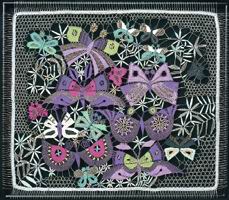Agáta Žáčková
This year is the 100th anniversary of the birth of a significant and very talented Slovak art personality, the national artist Elena Holéczyová. She was not only a significant artist but also a successful author of theatrical and radio plays, publications, director, scenographer and choreographer. She was influenced by authentic national traditions, customs and life feelings in her wide production. She is one of the great personalities of Slovak culture and art with her art philosophy, art credo and creative focus (mainly in bobbin lace).
Elena Holéczyová, nee Hollá, came from a family of several significant artistic personalities. Her birthplace– Moravské Lieskové – is situated in the Western part of Slovakia. Ethnographically it is an interesting and rich area where folk art during her childhood and early years was still very much alive in its full beauty and richness. An interest in folk art, mainly folk textile, led Elena Holéczyová to increase her knowledge of textile techniques used in this area of Slovakia. Elena Holéczyová became a recognized theoretician and experienced and knowledgeable about textile art.
At the end of the 1940s she worked in the Detva Group as a textile designer. She used to design decorative covers, tablecloths, small cloths, curtains, and decorative clothes accessories etc, which were later made in small series. She then directed her creative ambitions to the creation of bobbin lace. She started to change it from an intimate decorative element to an artefact of significant importance applied in the relationship to space and architecture.
The content of the bobbin laces of Elena Holéczyová deserves special attention. She based them mainly on folk culture and the art of Slovakia. Later, she used historical themes in relation to the development of the Slovak nation. Tales, Slovak folk songs, ballads, customs and habits were a frequent pattern in her creation. She was able to change and implement these with a rich artistic and creative imagination to their current shape.
Her first works from the beginnings of the 1950s were based on a traditional plant and the geometric ornaments of folk patterns. However, she enriched them by combining various lace-making techniques and a rich variation of the individual patterns. Only in later works did she move away from using the usual ornaments in folk textile, and her works in bobbin lace were enriched by figural themes. Continually she worked from a statically depicted figure or group of figures to express them in motion up to having a plot. Bobbins lacing a figure, concentration on expressing a movement depicted on the whole surface through the individual details lead her to implement always larger and in composition more demanding works that were also colourfully richer and cultivated.
